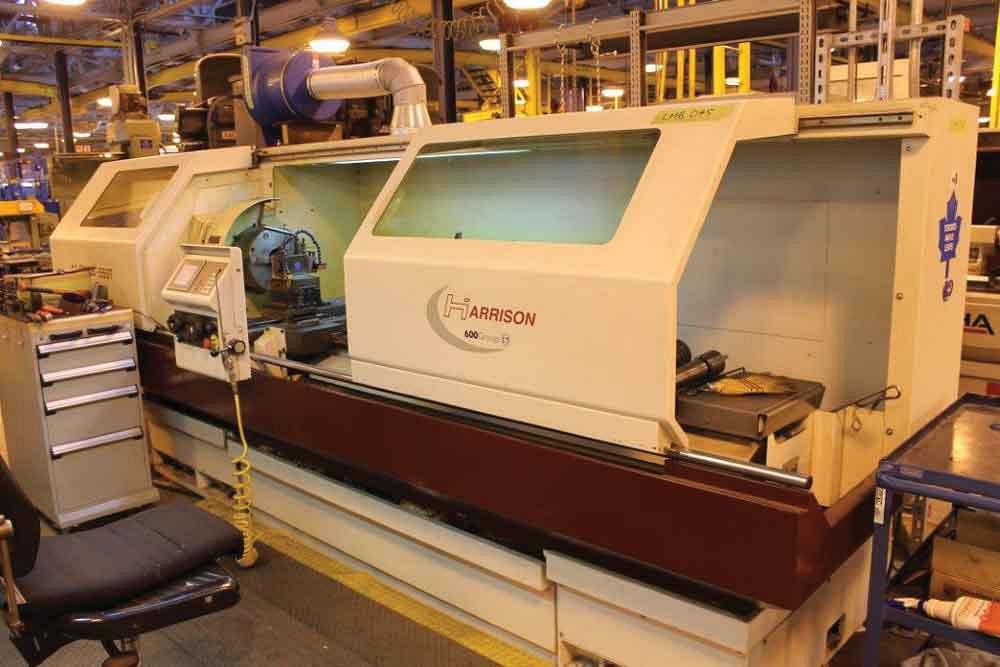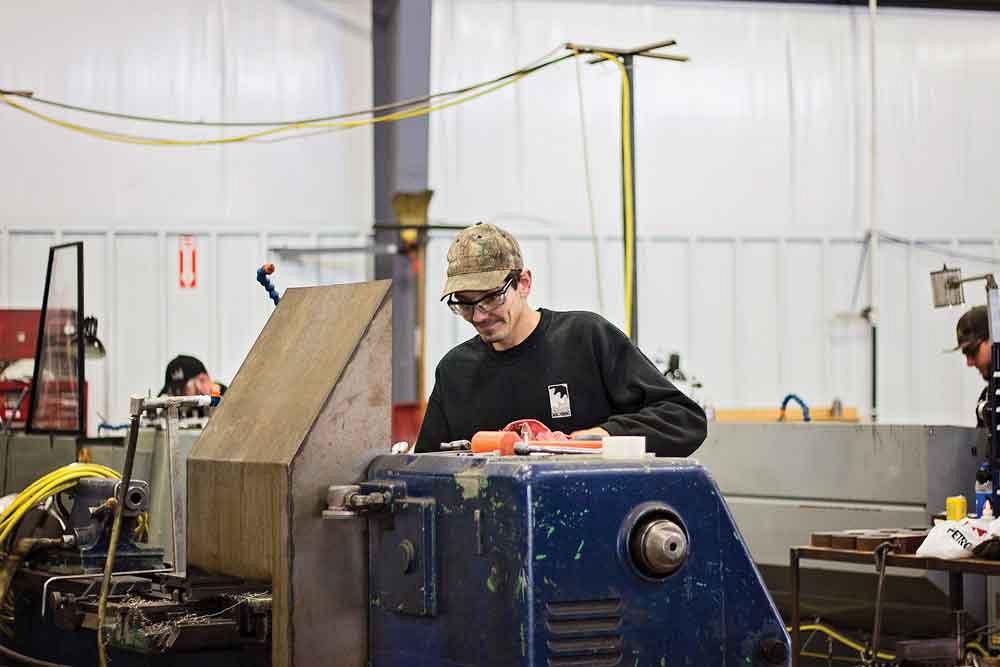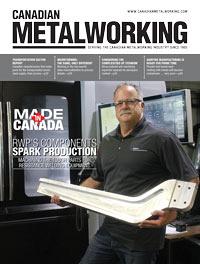Editor
- FMA
- The Fabricator
- FABTECH
- Canadian Metalworking
Transportation Sector Report
Canadian manufacturers that make parts for the transportation sector need supply chain access
- By Joe Thompson
- November 1, 2016
- Article
- Management

Co-owners Andy Race and Ron Wallace cut the ribbon at Ace Machining’s new, 14,500-sq.-ft. Dartmouth, N.S., location. Photo courtesy of Ace Machining.
On Sept. 30, 2016, job shop Ace Machining, Dartmouth, N.S., held a ceremony to mark the opening of its new shop. At 14,500 sq. ft., the new facility boasts an overhead crane and plenty of room for the company’s offices and 24 machine tools (five of which are CNC machines).
Ace presently is looking to add a waterjet to its equipment inventory, which also includes saws and welding machines.
Co-owners Ron Wallace and Andy Race expect revenues for 2016 to be 20 per cent higher than last year. They are even more forthcoming when it comes to discussing personnel.
“In August 2015 there were 13 of us. Now we’re at 20. It’s been a good year. Hopefully, it keeps going,” said Wallace.
Ace’s experience in the transportation sector (which covers buses, trains, and ships) highlights the vast opportunities available, as well as the arduous process of gaining access to these lucrative supply chains.
Among other jobs, Ace Machining makes snow plow parts for the Nova Scotia Department of Transportation and Infrastructure Renewal. It has been manufacturing these parts since 2008, and the contract now constitutes roughly 10 per cent of the company’s work load.
Ace works from engineered drawings submitted by the transportation department and mostly uses manual mills and lathes to machine the parts. The company won the job by responding to a public tender. Ace also works with the Halifax Regional Municipality, making “anything they ask” for its vehicles, said Race.
In addition, the company is looking at prospects in a different transportation sector. About six months ago, it picked up an assignment putting adjustable safety stops on jib cranes at the Halifax Shipyard run by transportation giant Irving Shipbuilding. The job is ongoing.
Dealing in Controlled Goods
To work for Irving, Ace first had to get registered with the Canadian government’s Controlled Goods Program (CGP)—a grueling procedure.
The CGP’s mandate is to strengthen the country’s defence trade controls through the mandatory registration and regulation of businesses that examine, possess, and transfer controlled goods. It covers products that have military or national security significance.
Ace began the registration process in the fall of 2012. Registration wasn’t granted until February 2013.
“It’s a lot of paperwork. It’s a question of whether or not you’re prepared to commit to it. How big do you want your company to grow? When we started this process, I saw it as moving the company forward,” said Wallace.
To become registered, “you have to have a clean background. They ask, Have you been involved in anything illegal? You want to have upstanding employees. You have to have a security plan in place at your operation as well as a quality plan. They physically audit your building. A few weeks ago, we went through an audit because we changed location. Their concern is, if their product is safe,” explained Wallace.
Government officials weren’t nearly as interested in Ace’s inventory and machining methods.
“They’re not concerned about the manufacturing process. They’re concerned about who has access to what,” said Wallace.
Once Ace was registered with the CGP, the company could join Irving’s online supplier portal. Qualified vendors on the portal receive emails citing specific jobs. Recipients can log in to the system and express interest if so inclined and indicate if they plan to bid for the job.
Cyclical Work
Work in the transportation sector can be quite cyclical. Ace Machining generally gets its snow plow assignments in the fall, for example, so the province can prepare for the coming winter season. Thanks to their Irving connection, management isn’t too concerned about seasonal ups and downs.

The Toronto Transit Commission runs its own machine shop to support repairs for streetcar components and provide subcomponents for traction and auxiliary motors for the city’s streetcar, subway, and bus fleets. Photos courtesy of the Toronto Transit Commission.
“They’re making boats now for the next decade,” Race pointed out.
He’s referring to the National Shipbuilding Strategy (NSS), a multi-year, multi-billion-dollar plan by Ottawa to produce cutting-edge combat and non-combat naval vessels. It’s an initiative that has delighted companies in the shipbuilding sector, while offering machine shops new opportunities to join the transportation supply chain.
As part of the move to the new building, Ace hired a consultant who recommended installing a dashboard-style quality control system and clearly marked tool stations.
“In the last shop, we had a finish bench. Now we have a full-blown area for quality control and inspection. We’ve also implemented a new job/work order system for better tracking [of jobs and] employee hours. It’s an all-round better system,” said Wallace.
For all the hassle it entailed, Ace management is pleased with its decision to get registered with the CGP to work for Irving.
Getting registered is “a lot of work. Since we’ve done it, there’s been little reward, but there’s maybe a golden egg out there that you might not ever have known about. It has opened a lot of doors for us. We’re just kind of standing in the doorway and haven’t stepped through it yet,” said Wallace.
Shipbuilding Contracts
According to Innovation, Science and Economic Development Canada, there were 581 ship- and boatbuilding establishments in Canada as of December 2014. Some 225 were in British Columbia, 82 were in Nova Scotia, 142 in Ontario, and 68 in Quebec.
North Vancouver-based Seaspan represents some of these firms. Seaspan describes itself as “an association of Canadian companies primarily involved in coastal marine transportation, ship docking/ship escort, ship repair, and shipbuilding services in western North America.”
In fall 2011 Seaspan won NSS contracts to build non-combat naval vessels for the Coast Guard and Royal Canadian Navy at the Vancouver Shipyards.
On Sept. 6, 2016, Seaspan held its second annual Atlantic Canada Industry Day in Halifax. Some 100 people representing more than 70 companies attended to learn more about shipbuilding initiatives and supply chain opportunities.
Over the first 10 years of the NSS Seaspan’s Vancouver Shipyards is projected to spend more than $1.3 billion with Canadian suppliers. In addition, it is estimated that this work will create more than 2,300 jobs.
Seaspan hosted a similar suppliers’ conference in North Vancouver in the summer of 2016. Seaspan runs its own online supplier portal. As with Irving, not just anyone can become a Seaspan vendor.
According to the company, its Supplier Relationship Management Program requires that all suppliers and contractors who want to do business with Seaspan or an affiliate company are prequalified based on their demonstrated ability to manage the health and safety, environmental, and quality aspects of the materials and contracted work.
Seaspan’s pitch has proven popular; so far, over 1,200 firms have expressed interest in working with the company on its NSS projects.
Of course, there’s a lot more to transportation than just ships.
When it comes to non-road-based transportation, Canada has one of the largest rail networks in the world.
According to “Rail Trends 2015,” a report by the Ottawa-based Railway Association of Canada, 2,696 locomotives and 59,000 freight cars were operating on 27,304 miles of rail in Canada in 2014.
“Canada’s railways moved more goods than ever before in 2014, continuing an upward trend that began in 2010 … freight rail traffic, as measured by revenue-ton-miles (RTM) rose to a record high of 306.3 billion RTM in 2014. This represents 5.2 per cent growth from the previous year and a 19.9 per cent increase over the 2009-2013 average of 255.5 billion RTM,” stated the report.
Bombardier of Montreal, top manufacturer of planes and trains in the world, makes some of the freight and passenger railcars travelling on Canadian track (and streetcars on city streets). Bombardier Transportation offers a webpage for wannabe transportation suppliers. Bombardier requires suppliers to be certified to the International Railway Industry Standard (IRIS). The latter is a global standard that “complements the internationally recognized ISO 9001 quality standard,” explains the IRIS website. Suppliers also have to be amenable to the Supplier Evaluation and Approval Process (SEAP, by which Bombardier evaluates and approves suppliers) and the Part Approval Process (PAP, through which purchased parts are judged for quality).
In-house Supply
Not all machining work is farmed out by transportation agencies, however. Many agencies and companies run their own in-house machine shops, in addition to using external suppliers for some tasks.
The Toronto Transit Commission (TTC) runs its own machine shop, for example. It makes parts for and services the city’s buses, streetcars, and subway trains. The shop is based in a larger facility called the D.W. Harvey Shop, which opened in March 1924. The TTC machine shop currently has 20 employees working in 23,500 sq. ft. of space.
“The machine shop primarily supports repairs for streetcar components, but also provides key subcomponents for traction and auxiliary motors for the streetcar, subway, and bus fleets. It ranges from qualifying and repairing components to machining new components that are no longer available from OEMs due to our aging fleets. Some of these components include custom pins, seals, retainers, and steel shoes (wear tips) for the streetcar emergency braking system. The machine shop also plays a big role in supporting the facilities’ motor repair section,” explained Joseph Perruccio, the machine shop’s foreman.
“The machine shop uses numerous machine tools, from conventional lathes, mills, grinders, saws, and drilling machines to CNC equipment. The shop is also fitted with presses ranging from 30 to 250 tons. The axle section within the machine shop uses these presses to overhaul streetcar axle assemblies while also repairing streetcar gearboxes and BAE hybrid bus gearboxes. We also have a specialized group of employees who remove/extract broken or ceased bolts, which we encounter when disassembling components that have been exposed to the elements for an extended period of time,” said Perruccio.
Contributing writer Nate Hendley can be reached at nhendley@sympatico.ca.
About the Author

Joe Thompson
416-1154 Warden Avenue
Toronto, M1R 0A1 Canada
905-315-8226
Joe Thompson has been covering the Canadian manufacturing sector for more than two decades. He is responsible for the day-to-day editorial direction of the magazine, providing a uniquely Canadian look at the world of metal manufacturing.
An award-winning writer and graduate of the Sheridan College journalism program, he has published articles worldwide in a variety of industries, including manufacturing, pharmaceutical, medical, infrastructure, and entertainment.
subscribe now


Keep up to date with the latest news, events, and technology for all things metal from our pair of monthly magazines written specifically for Canadian manufacturers!
Start Your Free Subscription- Industry Events
MME Winnipeg
- April 30, 2024
- Winnipeg, ON Canada
CTMA Economic Uncertainty: Helping You Navigate Windsor Seminar
- April 30, 2024
- Windsor, ON Canada
CTMA Economic Uncertainty: Helping You Navigate Kitchener Seminar
- May 2, 2024
- Kitchener, ON Canada
Automate 2024
- May 6 - 9, 2024
- Chicago, IL
ANCA Open House
- May 7 - 8, 2024
- Wixom, MI





















